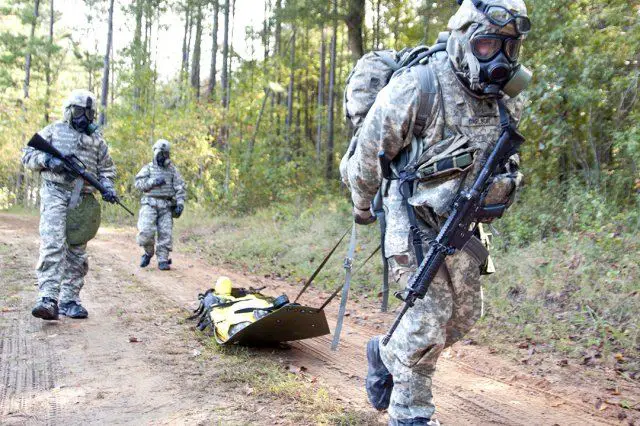New U.S. warfighter uniform with added protection against chemical warfare agents 12906154
|
|
|||
|
Military Defense Industry Technology - New warfighter uniform
|
|||
|
|
|||
| New U.S. warfighter uniform with added protection against chemical warfare agents. | |||
|
The U.S. Defense Threat Reduction Agency is leading an effort to design a new warfighter uniform - with added protection against chemical warfare agents encountered in the field. American army scientists are using both standard and new methods to test fabrics, which will be used in the new suit.
|
|||
|
|
|||
 Edgewood Chemical Biological Center researchers are part of a team looking to design a new warfighter uniform, which will decrease thermal burden to the warfighter while maintaining the same or better protection against chemical agents. (Photo U.S. army Sgt. 1st Class Andy Yoshimura) Edgewood Chemical Biological Center researchers are part of a team looking to design a new warfighter uniform, which will decrease thermal burden to the warfighter while maintaining the same or better protection against chemical agents. (Photo U.S. army Sgt. 1st Class Andy Yoshimura) |
|||
|
|
|||
|
The new uniform is designed to decrease thermal burden to the warfighter while maintaining the same or better protection against chemical agents. Different fabrics may be used in the uniform based on where heat is more common, like the chest and groin area; but a greater protection factor is needed for places where the warfighter is likely to come in contact with agent, such as on the shoulders, elbows or knees. The effort is part of a joint U.S. Army and Air Force program called the Integrated Protective Fabric System program. It is led by the U.S. Army Natick Soldier Research Development and Engineering Center, or NSRDEC, in Natick, Massachusetts, and the U.S. Air Force Civil Engineering Center. The Edgewood Chemical Biological Center, or ECBC, at Aberdeen Proving Ground, Maryland, is supporting the effort. Industry and academia are also partners in the program including Calgon/Chemviron, Emory University, Enropics and Phasex. In collaboration with NSRDEC, the ECBC Permeation and Analytical Solutions Branch recently tested agent absorption on different fabrics, which could be used. All testing needed to meet the chemical and biological defense program test and evaluation standards, as well as program requirements. "Natick brought us on board based on our previous work with them, as well as our unique ability to test using live agents and our understanding of transport phenomenon," said Brian MacIver, ECBC Permeation and Analytical Solutions branch chief. "The quality of our labs and test methods, and our reach-back support from subject-matter experts in toxicology and decontamination from across the center make us an ideal partner for this type of program." To test the fabrics, branch scientists used innovative and effective test methods to identify reactions. Scientists used three test methods - low-volatility agent permeation, air liquid vapor aerosol group and advanced super-shedding efficacy test - the latter being a brand-new capability developed specifically for this program. ECBC researchers recently developed the low-volatility agent permeation method, which will soon become an official test and evaluation method with the Department of Defense for VX permeation through protective equipment. The deputy undersecretary of the Army-test and evaluation evaluated the test, which permits the experimental evaluation of protective materials against contaminants that were traditionally difficult to analyze. Scientists used the air liquid vapor aerosol group test cell to evaluate multiple layers of experimental carbon and shell fabrics to measure quantitative permeation of specific agents through the material. From past development efforts, the scientists have been able to "well-characterize" the system and reduce variability in the data through more accurate control over testing variables that are inherent to it or any other test cell or device. The branch supported the development of "super-shedding" coating capability specifically for this program. A modification of the air liquid vapor aerosol group method, the advanced super-shedding efficacy test method uses a different application of agent to the material. "With this method, we aided NSRDEC in their development of fabric that sheds [repels] liquid contamination," said Christopher Steinbach, chemist. "The coating reduces agent permeation by allowing agent to run off the fabric." To perform the tests, scientists used the same advanced super-shedding efficacy test cells, but placed on a tilt table custom built by the ECBC researchers. The table was tilted at a range of 45 to 75 degrees so the agent could run off the fabric swatches. "The tilting represents a warfighter's movements, as well as the how the uniform will naturally conform to their body," Steinbach said. Then samples of air were pulled from the cells every few minutes to develop a curve for the growth of the concentration of agent on the fabric. Scientists monitored the cells in real time for 24 hours, with 13 to 26 cells being used at a time. "The higher throughput allows for better statistics for evaluation," Steinbach said. Testing will continue through fiscal 2015. Any necessary follow-on testing will be conducted at the request of NSRDEC. |
|||


























